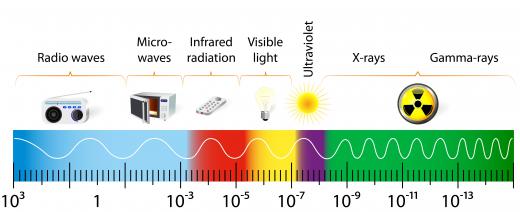What is Electromagnetic Radiation?
 Jessica Ellis
Jessica Ellis
Electromagnetic radiation is a term used to describe a stream of energy-bearing particles that travels outward from an electromagnetic source. The energy in these streams can vary extensively in power, and is measured by the electromagnetic spectrum. This type of radiation can be beneficial, harmless or extremely dangerous to humans, depending on the source, level of radiation, and duration of exposure.
There are both natural and man-made sources of electromagnetic radiation. The sun, for instance, is an intense source of radiation that can have both positive and negative effects on living things. The Sun also produces both visible and invisible electromagnetic streams. Ultraviolet rays from the sun are invisible and cause sunburn and skin cancer if overexposure occurs. A rainbow, however, is a visible and harmless part of the electromagnetic effect caused by the Sun, as human eyes detect the visible wavelengths of light as different colors.

Man-made sources of electromagnetic radiation include X-rays, radio waves, and microwaves, although some natural sources exist as well. Microwaves and radio waves are used by humans to power machines and increase communication abilities. Cell phones, radios, microwave ovens, and and radar all create electromagnetic radiation. This has lead to some concern that the growing prevalence of electromagnetic devices will lead to large increases in illnesses caused by radiation, such as cancer. As of yet, few studies suggest that exposure to household devices is strong enough to cause genetic mutation or cancer.

Scientists break down electromagnetic radiation into two types, non-ionizing and ionizing. Non-ionizing varieties include visible radiation, infrared radiation, and most types of low-energy radiation like radio and microwaves. Overexposure to non-ionizing radiation can cause burns to the skin, but is unlikely to cause genetic mutation or alter cellular structure. Ionizing radiation, such as that used in cancer treatments, is made up of high-energy wavelengths and can actually alter or mutate DNA. While this can be used to treat cell-affecting diseases like cancer, it can also cause serious and possibly fatal cellular damage leading to birth defects or radiation sickness.

The power contained in electromagnetic radiation can be both helpful and destructive to humans. Although it has become a vital part of technology, it also remains an enormous liability to human health. Overexposure to radiation, whether in an acute dose or a slow, continual intake, can quickly lead to illness and even a painful death. However, as this type of radiation is also a natural part of the human environment, exposure to some radiation is unavoidable.
AS FEATURED ON:
AS FEATURED ON:















Discussion Comments
What is the result of overexposure to radio waves?
@elama: At the beginning of the article you call em radiation as particle in nature. I understand that cosmic radiation and radioactive decay are particle, but when did em radiation become so? You need to check your facts or your credibility may take a hit.
this article is giving the overview of of EMR not explaining any aspect of it with reasons, so it should be improved.
read information on this topic. learned a lot from it.
This anemic essay on electromagnetic radiation (EM) fails to describe in any meaningful detail the processes that create EM, a rather significant omission.
Post your comments